Pontiac Parisienne
| Pontiac Parisienne Pontiac Grande Parisienne | |
|---|---|
.jpg) 1968 Pontiac Parisienne Sport Sedan | |
| Overview | |
| Manufacturer | Pontiac (General Motors) |
| Production | 1959–1987 |
| Assembly |
Oshawa Car Assembly, Oshawa, Ontario, Canada Australia [1] |
| Body and chassis | |
| Class | Full-size car |
| Layout | FR layout |
| Chronology | |
| Predecessor |
Pontiac Catalina (For U.S.) Pontiac Bonneville (original full-size model) |
The Pontiac Parisienne is a full-size rear-wheel drive vehicle that was sold by Pontiac on the GM B platform in Canada from 1958 to 1986 and in the United States from 1983 to 1986. The Parisienne wagon continued under the Safari nameplate until 1989.
Differences from US Pontiacs
The Parisienne entered the production lineup as a sub-series within the Laurentian line in the 1958 model year. Parisienne became a separate model in 1959.
For most of its life, the Parisienne was the Canadian nameplate for the top-of-the-line model sold in GM of Canada's Pontiac showrooms. Parisiennes were distinct from other Canadian Pontiac models by their standard features: the luxuriousness of upholstery fabrics; standard equipment such as courtesy interior and trunk lights; bright trim mouldings in the interior; distinct exterior accent chrome pieces; and availability of two- and four-door hardtops and convertibles.
In particular, Canadian "full size" Pontiacs were actually closely related to Chevrolets, making use of the economical Chevrolet chassis and drivetrain, though with the American Pontiac-styled exterior body panels (They weren't the same as U.S. Pontiac panels since they had to fit the shorter-wheelbase 119-inch Chevrolet "X" frame. U.S. Pontiacs used a full perimeter frame.) and interior instrument panels. As Chevrolets under the skin, Canadian Pontiacs including the Parisienne used the same engines and transmissions as full-size Chevys, including the 230 and 250 cubic inch 6 cylinder and 283, 307, 327, 350, 396, 400, 409, 427 and 454 cu inch V8s. These engines were mated to the same transmissions as Chevrolet, including 3 and 4 speed manual and the 2 speed Powerglide and later the three-speed Turbo-Hydramatic automatic transmissions.
The first Parisienne, offered for the 1958 model year, was a super deluxe "halo" model in the Laurentian line, much like Chevrolet's Bel Air Impala of the same year. Chevrolet's Ramjet fuel injection system, introduced in 1957 in the U.S., was a Parisienne option as well. It was marketed as the "Power Chief" option, but it was identical to Chevy's Ramjet. Also available for the first year Parisienne was Chevrolet's Turboglide automatic transmission.
Built in the same GM of Canada assembly plant in Oshawa, Ontario, Pontiacs had parallel model lineups as "full size" Chevrolets: the Pontiac "Strato Chief" had similar trim level and upholstery as Chevrolet's "Biscayne", the "Laurentian" matched the trim level of the Chevrolet "Bel Air" and while the Parisienne offered similar amenities as Chevrolet's "Impala", the Pontiac version had unique and more costly upholstery fabrics, and beginning in 1964 the "Custom Sport" (later rebadged the "2+2") two-door hardtop and convertible model line was in lock-step with Chevrolet's "Super Sport". Finally, starting in 1966 Pontiac offered the "Grande Parisienne", a two-door and four-door hardtop models parallel to Chevrolet's luxurious "Caprice," although Grande Parisiennes through 1968 used the styling of the US-market Grand Prix. Though most of its life, the Parisienne resembled the US-market Bonneville despite its Chevrolet underpinnings.
In contrast, the Pontiac Motor Division of GM in the US manufactured models with drivetrains, chassis and equipment unique from the other GM stablemates—Chevrolet, Oldsmobile, Buick, and Cadillac. Through much of the 1950s through 1970s, the American Pontiac model lineup included the "Catalina", "Ventura", "Executive", "Star Chief" and as the top of the line model, the "Bonneville". Additionally, unique to the US lineup until 1969 was the "Grand Prix", a distinct 2-door hardtop model with unique styling features and both luxury and "sporty" accoutrements such high output V8s, bucket seats, tachometers and flashy trim pieces.
The mix of Pontiac exterior styling on an economical Chevrolet chassis and drivetrain at a price point marginally higher than Chevrolet, was a huge marketing success for GM of Canada. For decades "full-size" Pontiacs took third place behind Chevrolet and Ford in sales, typically 70,000 plus units annually. In contrast, heavier and bulkier American Pontiacs, with far higher sticker prices and higher operating costs due to large displacement V8s requiring high octane fuel, would have little appeal in the Canadian marketplace for a number of reasons: a population base one tenth the size of the US, a less stratified society with lower disposable incomes, more prudent spending and savings sensibilities and far higher taxes and gasoline prices. On the manufacturing side, maintaining unique part availability for a low sales vehicle along with import-export tariffs and barriers between the U.S. and Canada would make the sale of American Pontiacs unprofitable in Canada.

In 1977, GM had downsized its full-sized lineup. Pontiac continued with the Catalina and Bonneville nameplates it had used since 1973, but the cars failed to manage the sales volume of their divisional siblings and were dropped completely in 1981. However, the Bonneville name was then simply switched to the smaller G-body Pontiac (the cousin of the Chevrolet Malibu, Oldsmobile Cutlass, and Buick Regal) for 1982. Previously, those cars had been sold as the LeMans, but sales were poor and GM decided to swap nameplates on the grounds that Bonneville carried higher name recognition among customers.
With the recession of 1979–82 lifting and gas prices beginning to drop, sales of larger cars began to pick up and so Pontiac dealers began demanding the return of the full-sized B-body line. However, the assembly plants used for the Catalina/Bonneville had been converted over to other uses, thus GM had to now source Pontiac B-bodies from Canada, where the line had not been discontinued.
Even though the re-sized Bonneville was also sold in Canada, the full-size Parisienne continued for 1982, although its distinct Pontiac front- and rear-end treatments and interiors were largely replaced with Chevrolet components (described in detail below). At the request of US Pontiac dealerships who still wanted a full-size rear wheel drive car to replace the lost U.S. market share and gain back traditional Pontiac customers who longed for a large rear wheel drive car, the Parisienne was imported from Oshawa, Ontario, Canada and sold in the United States beginning in the 1983 model year, retaining the model name "Parisienne" and specs from the Canadian original. Externally, it was a rebadged Chevrolet Impala (1983-84 models (and 1982 in Canada) had the Impala rear taillight panel fitted with Pontiac-spec taillight lenses, whereas the nose was borrowed from the Chevrolet Caprice fitted with a Pontiac grille). The 1985 and 1986 models resumed use of the rear-end styling from the 1980 to 1981 Bonneville. Two Parisienne ranges were sold: a base model (similar to the former Catalina and the then-current Oldsmobile Delta 88 Royale) in four-door sedan and Safari station wagon form, and a more-luxurious Brougham four-door sedan (with velour upholstery that featured loose-pillow fitted seats). The two-door version of the 1977-81 B-bodies did not return to the US market, although it persisted in Canada through 1983.
First generation: 1959-60
| First generation | |
|---|---|
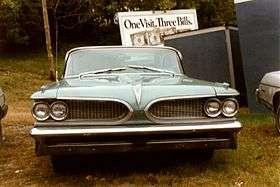 1959 Pontiac Parisienne | |
| Overview | |
| Model years | 1959–60 |
| Body and chassis | |
| Body style |
2-door convertible 2-door coupe 4-door sedan 4-door station wagon |
| Powertrain | |
| Engine |
261 cu in (4.3 L) I6 283 cu in (4.6 L) V8 348 cu in (5.7 L) V8 |
| Transmission |
2-speed automatic 3-speed automatic 3-speed manual 4-speed manual |
 1959 Pontiac Parisienne Sport Coupe
1959 Pontiac Parisienne Sport Coupe 1960 Pontiac Parisienne Convertible
1960 Pontiac Parisienne Convertible
Second generation: 1961–1964
| Second generation | |
|---|---|
|
1961 Pontiac Parisienne sedan | |
| Overview | |
| Model years | 1961–1964 |
| Assembly |
Oshawa Car Assembly , Oshawa, Ontario , Canada, Australia [1] |
| Body and chassis | |
| Body style |
2-door convertible 2-door coupe 4-door sedan 4-door hardtop [2] 4-door station wagon |
| Platform | B-body |
| Related |
Buick LeSabre Chevrolet Bel Air Chevrolet Impala Pontiac Catalina/Laurentian |
| Powertrain | |
| Engine |
261 cu in (4.3 L) I6 230 cu in (3.8 L) I6 283 cu in (4.6 L) V8 327 cu in (5.4 L) V8 348 cu in (5.7 L) V8 409 cu in (6.7 L) V8 |
| Transmission |
2-speed automatic 3-speed automatic 3-speed manual 4-speed manual |
| Dimensions | |
| Wheelbase | 119.0 in (3,023 mm) |
- 1962 Pontiac Parisienne convertible
.jpg) 1963 Pontiac Parisienne Sport Coupe. Side trim resembles U.S. market Bonneville.
1963 Pontiac Parisienne Sport Coupe. Side trim resembles U.S. market Bonneville. 1963 Pontiac Parisienne Sport Sedan (Australia)
1963 Pontiac Parisienne Sport Sedan (Australia)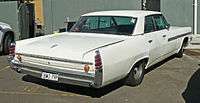 1963 Pontiac Parisienne Sport Sedan (Australia). Rear trim is similar to U.S. Catalina, while front trim is close to the Bonneville
1963 Pontiac Parisienne Sport Sedan (Australia). Rear trim is similar to U.S. Catalina, while front trim is close to the Bonneville.jpg) 1964 Pontiac Parisienne Sport Sedan. Note Chevrolet type parallel wipers; U.S. market Pontiacs had "clapper" windshield wipers.
1964 Pontiac Parisienne Sport Sedan. Note Chevrolet type parallel wipers; U.S. market Pontiacs had "clapper" windshield wipers.
Third generation: 1965–1970
| Third generation | |
|---|---|
.jpg) 1968 Pontiac Grande Parisienne Sport Sedan [3] | |
| Overview | |
| Model years | 1965–1970 |
| Assembly |
Oshawa Car Assembly , Oshawa, Ontario , Canada, Australia [4] |
| Body and chassis | |
| Body style |
2-door convertible 2-door coupe 4-door sedan 4-door hardtop [4] 4-door station wagon |
| Platform | B-body |
| Related |
Buick LeSabre Chevrolet Bel Air Chevrolet Caprice Chevrolet Impala Pontiac Catalina/Laurentian |
| Powertrain | |
| Engine |
283 cu in (4.6 L) V8 [5] 327 cu in (5.4 L) V8 [6] 350 cu in (5.7 L) V8 396 cu in (6.5 L) V8 427 cu in (7.0 L) V8 454 cu in (7.4 L) V8 (replaced 427 in 1970) |
| Transmission |
2-speed automatic 3-speed automatic 3-speed manual 4-speed manual |
| Dimensions | |
| Wheelbase |
119.0 in (3,023 mm) 121.0 in (3,073 mm) for Parisienne |
In 1965 Pontiac Parisienne differs from US Bonneville mainly by front grille, which was taken from US 1965 Pontiac Grand Prix. 1967 brought new styling including new grills.[7] There were also new safety features, such as a collapsible steering column and dual braking system.[8]
.jpg) 1965 Pontiac Parisienne Convertible
1965 Pontiac Parisienne Convertible.jpg) 1966 Pontiac Parisienne Convertible
1966 Pontiac Parisienne Convertible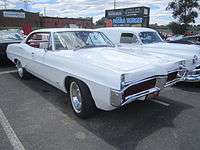 1967 Pontiac Parisienne Sport Sedan
1967 Pontiac Parisienne Sport Sedan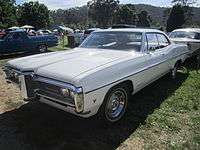 1968 Pontiac Parisienne Sport Sedan
1968 Pontiac Parisienne Sport Sedan- 1969 Pontiac Parisienne Sport Sedan
 1970 Pontiac Parisienne Convertible
1970 Pontiac Parisienne Convertible
Fourth generation: 1971–1976
| Fourth generation | |
|---|---|
.jpg) 1976 Pontiac Parisienne Sedan | |
| Overview | |
| Model years | 1971–1976 |
| Body and chassis | |
| Body style |
4-door hardtop 2-door coupe 4-door sedan |
| Platform | B-body |
| Related |
Buick LeSabre Chevrolet Bel Air Chevrolet Caprice Chevrolet Impala Oldsmobile 88 Pontiac Catalina/Laurentian |
| Powertrain | |
| Engine |
455 cu in (7.5 L) V8 400 cu in (6.6 L) V8 |
| Dimensions | |
| Wheelbase | 123.4 in (3,134 mm) |
For 1971, GM's new "B" and "C" bodies were the largest ever produced. During this generation, the Chevrolet engines were replaced for the first time with the same powerplants as U.S. market Pontiacs. Thus, the Pontiac 455 cubic-inch V8 was now offered as an option. The Grande Parisienne was now virtually the same car as the U.S. Grand Ville.
During this generation, the U.S. market Bonneville and Catalina models were also available in Canada for the first time, in addition to Laurentians and Parisiennes.
.jpg) 1972 Pontiac Parisienne Brougham Hardtop Coupe
1972 Pontiac Parisienne Brougham Hardtop Coupe.jpg) 1974 Pontiac Parisienne Brougham 4-door Hardtop
1974 Pontiac Parisienne Brougham 4-door Hardtop.jpg) 1976 Pontiac Parisienne 4-door Sedan
1976 Pontiac Parisienne 4-door Sedan
Fifth generation: 1977–1986
| Fifth generation | |
|---|---|
.jpg) 1984-86 Pontiac Parisienne Sedan | |
| Overview | |
| Model years | 1977–1986 |
| Body and chassis | |
| Body style |
2-door coupe 4-door sedan 4-door station wagon |
| Platform | B-body |
| Related |
Buick LeSabre Chevrolet Caprice Chevrolet Impala Oldsmobile 88 Pontiac Catalina/Laurentian |
| Powertrain | |
| Engine |
231 cu in (3.8 L) Buick V6 265 cu in (4.3 L) Pontiac V8 301 cu in (4.9 L) Pontiac V8 305 cu in (5.0 L) Chevrolet V8 350 cu in (5.7 L) Pontiac V8 350 cu in (5.7 L) Oldsmobile Diesel V8 400 cu in (6.6 L) Pontiac |
| Dimensions | |
| Wheelbase | 116.0 in (2,946 mm) |
Starting in 1977, all full-size GM cars were downsized, losing hundreds of pounds in weight and featuring smaller but more trim and squarish bodies. This allowed for smaller displacement engines, which made these new cars more fuel-efficient.
Pontiac of Canada continued to offer the Parisienne in this new size. Like before, Canadian Pontiacs were virtual clones of the Chevrolet Caprice, with a slightly different grille insert, and different taillight trim. The new Pontiacs featured Chevrolet straight-six and small-block V8 engines.
Coupe, sedan and wagon models were available. These cars were available virtually unchanged (except for minor styling updates) through 1986.
This is the only generation of the Parisienne that was available in the United States.
- 1977 Pontiac Parisienne coupe
 1978 Pontiac Parisienne coupe
1978 Pontiac Parisienne coupe 1980 Pontiac Parisienne sedan
1980 Pontiac Parisienne sedan- 1980 Pontiac Parisienne coupe
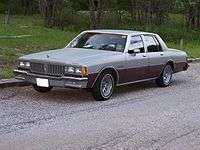 1983 Pontiac Parisienne
1983 Pontiac Parisienne
Exports
Right-hand drive Pontiac Parisiennes and Laurentians were manufactured in Canada for export to some countries such as Australia, U.K. etc., until 1969. The '61-'64 models had the '61 Pontiac dash reversed for RHD (also shared with Chevrolets) and '65 to '69 used an adapted version of the 1965 Chevrolet Impala dash panel until 1969, again shared with Chevrolets. Pontiac right hand drive "kit cars" crated at GM's Oshawa, Ontario manufacturing plant were shipped to Australia and assembled at GM's Holden plant using some domestic parts such as seats, heaters, opposing windscreen wipers and 2 speed ventilation systems. Australian cars were CKD (welded and painted locally) while SKD cars, completed body locally assembled to frame, were shipped to New Zealand. Pontiac "kit cars" were also assembled in South Africa and Europe.
Successor
The Parisienne still sold well when GM decided to drop the line after the 1986 model year with no replacement. A front wheel drive model with the Bonneville name had similar dimensions versus the 1982 mid-size model, classifying the car as a full-size by the EPA; however, the wagon model (known just as "Safari") continued until 1989.
While the Parisienne name was retired in 1986, big Pontiac fans got a completely new, but full-sized, Bonneville for 1987. This car featured front-wheel drive and a V6 as standard, in line with the contemporary Cadillac, Buick and Oldsmobile big models. Rear-wheel drive sedans returned to the Pontiac lineup with the Holden-sourced Pontiac G8 in 2008.
References
- 1 2 More local content knocks down the price of the New Pontiac Parisienne, Australian Motor Manual, July 1964, page 6
- ↑ Norm Darwin, 100 Years of GM in Australia, January 2002, page 161
- ↑ 1968 Pontiac Grande Parisienne Sport Sedan (Canada), digitalpostercollection.com Retrieved on 22 April 2014
- 1 2 Norm Darwin, 100 Years of GM in Australia, January 2002, page 163
- ↑ 1966 Holden Pontiac Parisienne Brochure, www.oldcarbrochures.org Retrieved on 22 April 2014
- ↑ 1968 Holden Pontiac Parisienne Brochure, www.oldcarbrochures.org Retrieved on 22 April 2014
- ↑ http://oldcarbrochures.org/New-Brochures---October/1967-Pontiac-Parisienne-Brochure-Aus/1967-Pontiac-Parisienne-Aus--04-05
- ↑ http://oldcarbrochures.org/New-Brochures---October/1967-Pontiac-Parisienne-Brochure-Aus/1967-Pontiac-Parisienne-Aus--10-11
| Wikimedia Commons has media related to Pontiac Parisienne. |
| « previous — Pontiac, a division of General Motors, automobile timeline, 1980s–2010 | |||||||||||||||||||||||||||||||
|---|---|---|---|---|---|---|---|---|---|---|---|---|---|---|---|---|---|---|---|---|---|---|---|---|---|---|---|---|---|---|---|
| Type | 1980s | 1990s | 2000s | 2010 | |||||||||||||||||||||||||||
| 0 | 1 | 2 | 3 | 4 | 5 | 6 | 7 | 8 | 9 | 0 | 1 | 2 | 3 | 4 | 5 | 6 | 7 | 8 | 9 | 0 | 1 | 2 | 3 | 4 | 5 | 6 | 7 | 8 | 9 | 0 | |
| Subcompact | Sunbird | T1000 | 1000 | LeMans | Matiz/G2 | Matiz/Matiz G2 | |||||||||||||||||||||||||
| Acadian | |||||||||||||||||||||||||||||||
| Sunburst | |||||||||||||||||||||||||||||||
| Firefly | Firefly | Firefly | Firefly | Wave | G3 | ||||||||||||||||||||||||||
| Compact | J2000 | 2000 | Sunbird | Sunbird | Sunfire | Pursuit/G4/G5 | |||||||||||||||||||||||||
| Tempest | Vibe | Vibe | |||||||||||||||||||||||||||||
| Phoenix | Grand Am | Grand Am | Grand Am | G6 | |||||||||||||||||||||||||||
| Mid-size | LeMans | Bonneville | Grand Prix | Grand Prix | Grand Prix | ||||||||||||||||||||||||||
| Grand Am | 6000 | ||||||||||||||||||||||||||||||
| Full-size | Laurentian | ||||||||||||||||||||||||||||||
| Catalina | |||||||||||||||||||||||||||||||
| Parisienne | Bonneville | Bonneville | Bonneville | G8 | |||||||||||||||||||||||||||
| Bonneville | |||||||||||||||||||||||||||||||
| Station wagon | Safari | ||||||||||||||||||||||||||||||
| Mid-size crossover | Aztek | Torrent | |||||||||||||||||||||||||||||
| Compact SUV | Sunrunner | ||||||||||||||||||||||||||||||
| Minivan | Trans Sport | Trans Sport/Montana | Montana SV6 | ||||||||||||||||||||||||||||
| Personal luxury | Grand Prix | ||||||||||||||||||||||||||||||
| Muscle car | Firebird | Firebird | Firebird | GTO | |||||||||||||||||||||||||||
| Sports | Fiero | Solstice | |||||||||||||||||||||||||||||
| Red denotes models which are exclusive to Canada | |||||||||||||||||||||||||||||||
| Green denotes models which are exclusive to Mexico | |||||||||||||||||||||||||||||||